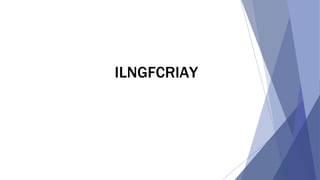
TEACHING IN ENGLISH REPORT.pdf
- 1. ILNGFCRIAY
- 2. CLARIFYING
- 7. KBDEECA
- 8. FEEDBACK
- 9. Formative Assessment: A Definition Formative assessment is a planned, ongoing process used by all students and teachers during learning and teaching to elicit and use evidence of student learning to improve student understanding of intended disciplinary learning outcomes and support students to become self-directed learners.
- 10. Key Formative Assessment Practices Effective use of the formative assessment process requires students and teachers to integrate and embed the following practices in a collaborative and respectful classroom environment: ● Clarifying learning goals and success criteria within a broader progression of learning ● Eliciting and analyzing evidence of student thinking ● Engaging in self-assessment and peer feedback ● Providing actionable feedback ● Using evidence and feedback to move learning
- 11. Clarifying learning goals and success criteria within a broader progression of learning Learning intentions are stated using words that emphasise knowledge, skills, concepts and/or attitudes. Students are reminded about the links between what they are learning and the big learning picture Child-friendly language is used to share learning intentions with students Students demonstrate that they are using learning intentions and/ or success criteria while they are working 19
- 12. Eliciting and analyzing evidence of student thinking • Assessment techniques are used to facilitate class discussion •Students are encouraged to share the questioning role with the teacher during lessons • Students’ incorrect responses are used to guide teaching and learning • Students can explain to others what they are learning
- 13. Engaging in self-assessment and peer feedback • Students are given an opportunity to indicate how challenging they anticipate the learning will be at the beginning of a lesson or activity • Students are encouraged to use a range of assessment techniques to review their own work •A visual record of students’ progress is maintained to celebrate students’ learning and show areas of/for development • Time is set aside during parent/guardian-teacher meetings for students to be involved in reporting on some aspects of their learning
- 14. Providing actionable feedback Providing ongoing feedback to close the gap between where the student is and their learning goals • Feedback to students is focused on the original learning intention(s) and success criteria • Assessment techniques are used during lessons to help the teacher determine how well students understand what is being taught • Students are involved formally in providing information about their learning to their parents/guardians • In preparing to provide students with feedback on their learning, the teacher consults their records of achievement against key learning intentions from previous lessons
- 15. Using evidence and feedback to move learning strategies, goals, or next instructional steps. Gathering Evidence of Student Learning All AfL strategies are predicated on gathering evidence of student learning and engaging in assessment activities on that evidence. • Observations include teacher or peer observations of student performance and can be recorded digitally or via more traditional anecdotal records. Guiding observational assessment may be the use of a rubric or assessment guide.
- 16. • Conversations provide opportunities for in-the-moment, responsive feedback. Through dialogue, teachers and peers can assess students’ understandings and support next steps. Again, conversations can be guided through standardised protocols or, as is the case most often, occur spontaneously throughout learning activities. • Products have traditionally been the subject of the majority of assessment activities in classrooms. Products refers to any artifact of student work from a quiz/test to essay to performance/presentation or other constructed assignment.
- 17. SHORT QUIZ 1. A process used by all students and teachers during learning and teaching to elicit and use evidence of student learning to improve student understanding 2. Student learning and engaging in assessment activities on that evidence. 3. To close the gap between where the student is and their learning goals 4. An opportunity to indicate how challenging they anticipate the learning will be at the beginning of a lesson or activity. 5. Students demonstrate that they are using learning intentions and/ or success criteria while they are working